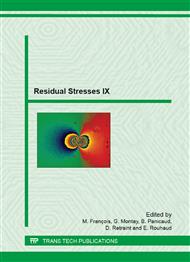p.761
p.769
p.775
p.782
p.788
p.794
p.801
p.808
p.814
Numerical Investigation of Welding Residual Stress Field and its Behaviour under Multiaxial Loading in Tubular Joints
Abstract:
The lack of clarities in estimating the residual stress threat to the structural integrity has led to conservative assumptions in the current design of welds. The complexities become more in the case of multiaxial loading of welded structure, considering fracture or fatigue. To what extent the residual stresses influence the performance of a welded structure, depends on how stable they are under service loads. Finite element analyses are used here to describe the development of welding residual stresses in tubular joints and their relaxation under multiaxial loading. It is observed that the effect of the torsion load is more significant than the effect of tension load in releasing of the residual stresses. For pure tensile loading, the relaxation of the residual stresses are negligible as long as the applied load is lower than 50% of the yield strength of the material. For a combined tension-torsion loading of 75% of the yield strength, the residual stresses are almost completely released, and in the weld zone they become compressive.
Info:
Periodical:
Pages:
788-793
Citation:
Online since:
August 2014
Authors:
Permissions:
Share:
Citation:


